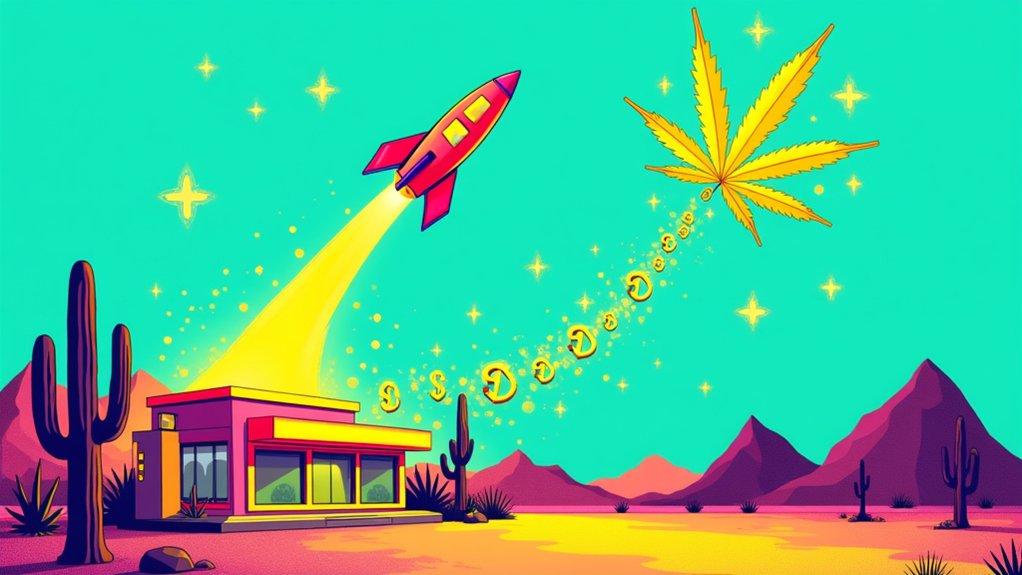Arizona’s cannabis market operates like an exclusive club with a velvet rope. The state caps dispensary licenses based on pharmacy density, creating artificial scarcity that transforms ordinary storefronts into multi-million-dollar assets. Established dispensaries now command valuations exceeding $10 million, while newcomers face a nearly impossible entry barrier. This controlled supply meets explosive consumer demand, triggering a feeding frenzy among investors and consolidators. The mathematics are simple, but the implications for existing operators are anything but ordinary.
While many states have embraced open cannabis licensing that floods markets with dispensaries, Arizona has taken a strikingly different approach by tying its cannabis licenses directly to pharmacy density. The state restricts dispensary licenses to roughly one per ten pharmacies, creating approximately 143–171 licenses statewide as of 2025. This scarcity model has transformed cannabis businesses into premium assets worth millions.
The license caps are strictly enforced, with new permits rarely issued unless pharmacy numbers increase or through special equity programs. This contrasts sharply with states like Oklahoma or New Mexico, where open licensure has created market oversaturation. Arizona’s approach has fundamentally created a controlled monopoly where existing license holders enjoy protected market positions.
The impact on business valuations has been dramatic. Established dispensaries in Arizona regularly command valuations exceeding $10 million, with scarcity driving premium acquisition prices as licenses become the primary bottleneck for market entry. License resale values have skyrocketed, with investors paying substantial premiums to acquire operational entities rather than attempting the nearly impossible task of securing new permits.
This scarcity fuels aggressive consolidation as larger firms purchase smaller licensees to expand market share. The barriers to competition allow current operators to maintain higher margins and stronger market positions than their counterparts in oversaturated markets. It’s a classic supply and demand scenario where limited supply meets growing consumer interest.
Arizona legalized recreational cannabis in 2020, and the industry now generates over $1.26 billion annually with a growth rate of approximately 14.4%. The fast rollout from legalization to commercial sales created rapid profitability for license holders, while the caps prevented market oversaturation that typically drives down revenues.
Arizona’s dual-use licensing system adds another layer of efficiency that boosts valuations. A single license covers both medical and recreational sales, streamlining operations and allowing businesses to maximize inventory turnover and customer base. Most of the state’s licensed establishments operate under this dual-use model, reducing administrative burden compared to states requiring separate permits. This approach creates a stark contrast with Mexico, where legal limbo continues despite a 2018 Supreme Court ruling declaring cannabis prohibition unconstitutional.
The Arizona Department of Health Services maintains strict regulatory oversight with regular audits, mandatory product testing, and thorough safety standards. The application process demands extensive documentation, including detailed business plans and proof of funding, creating additional barriers that protect existing operators. Beyond the initial investment, operators face application fees of approximately $25,000 for dispensary licenses. The annual renewal fee of $5,000 creates ongoing costs that established operators can easily absorb while potentially discouraging new entrants.
Strong consumer demand combined with limited competition continues boosting revenues for existing businesses. The license scarcity has created a unique market dynamic where established operators enjoy both growing demand and protected market share.
Social equity licensing has introduced a separate set of limited licenses to address historic disparities, but these additions remain minimal compared to overall market demand. The result is a cannabis market where licenses function more like rare commodities than standard business permits, driving valuations to levels that would seem impossible in open-license states. For current license holders, Arizona’s restrictive approach has fundamentally created a golden ticket scenario.










